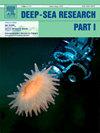Petrogenesis of igneous rocks from the Yap Arc, west Pacific: implications for its tectonic evolution
IF 2.1
3区 地球科学
Q2 OCEANOGRAPHY
Deep-Sea Research Part I-Oceanographic Research Papers
Pub Date : 2025-08-21
DOI:10.1016/j.dsr.2025.104577
引用次数: 0
Abstract
The Yap arc-trench system was formed by the westward subduction of the Pacific/Caroline Plate beneath the Philippine Sea Plate (PSP) and was subsequently influenced by the jam of the Caroline Plateau into the Yap Trench. This makes it an ideal area for deciphering the geological evolution of an island arc when an oceanic plateau approaches a subduction zone. In the present study, we analyzed the mineralogical, geochemical, and isotopic compositions of peridotite, gabbroic diorite, and volcanic rocks collected from the southern Yap Arc. The results show that: (1) the peridotites are forearc peridotites, representing residues after 10–15 % partial melting of the sub-arc mantle wedge, caused by fluids released from the subducted slab during the subduction of the oceanic plateau. These peridotites were subsequently exposed in the Yap Arc due to tectonic erosion of the subducting plate. (2) The Yap Arc gabbro diorites share similarities with infant arc lavas and may have formed through a relatively low degree of partial melting of sub-arc basic rocks. (3) The Yap Arc basalts were produced by 2–5 % partial melting of the southern Yap peridotites under the influence of approximately 0.5 % sediment input. These basalts exhibit characteristics typical of the Pacific MORB-type mantle. (4) The andesites of the Yap Arc were formed through partial melting of preexisting basic rocks at the arc front, influenced by 0.5–1 % sediment melt. Hf-Nd isotopic characteristics of the southern Yap Arc basalts have validated the entry of Pacific MORB-type mantle into the Yap sub-arc mantle via a slab gap.
西太平洋雅浦弧火成岩成因及其构造演化意义
雅浦弧-海沟体系是由太平洋/卡洛琳板块向西俯冲到菲律宾海板块之下形成的,随后受到卡洛琳高原向雅浦海沟塞入的影响。当海洋高原接近俯冲带时,这使它成为破译岛弧地质演化的理想区域。本文对采自南雅普弧的橄榄岩、辉长闪长岩和火山岩进行了矿物学、地球化学和同位素组成分析。结果表明:(1)该橄榄岩为弧前橄榄岩,为洋基高原俯冲过程中俯冲板块释放的流体对弧下地幔楔部分熔融后的残余岩。由于俯冲板块的构造侵蚀,这些橄榄岩随后在雅浦弧暴露出来。(2)崖弧辉长闪长岩与幼弧熔岩有相似之处,可能是由次弧基性岩较低程度的部分熔融形成的。(3)雅浦弧玄武岩是在约0.5%的沉积物输入作用下,由南雅浦橄榄岩部分熔融2 ~ 5%形成的。这些玄武岩具有典型的太平洋morb型地幔特征。(4)雅普弧安山岩是由弧前原基性岩部分熔融形成的,受0.5 ~ 1%沉积物熔融的影响。南雅浦弧玄武岩的Hf-Nd同位素特征证实了太平洋morb型地幔通过板块间隙进入雅浦次弧地幔。
本文章由计算机程序翻译,如有差异,请以英文原文为准。
求助全文
约1分钟内获得全文
求助全文
来源期刊
CiteScore
4.60
自引率
4.20%
发文量
144
审稿时长
18.3 weeks
期刊介绍:
Deep-Sea Research Part I: Oceanographic Research Papers is devoted to the publication of the results of original scientific research, including theoretical work of evident oceanographic applicability; and the solution of instrumental or methodological problems with evidence of successful use. The journal is distinguished by its interdisciplinary nature and its breadth, covering the geological, physical, chemical and biological aspects of the ocean and its boundaries with the sea floor and the atmosphere. In addition to regular "Research Papers" and "Instruments and Methods" papers, briefer communications may be published as "Notes". Supplemental matter, such as extensive data tables or graphs and multimedia content, may be published as electronic appendices.

 求助内容:
求助内容: 应助结果提醒方式:
应助结果提醒方式:


